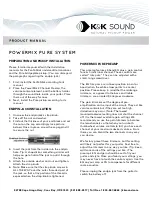
SI-BF-100
World Precision Instruments
25
In Fig. 42, NADH is represented in red and TAMRA is represented in blue. The
intrinsic absorbencies of the molecules are represented by dashed lines. The
emission spectra are represented by solid lines. In this case, the optimal site for
excitation for both molecules with the same wavelength of light occurs at the peak
absorbance of NADH and secondary absorbance of TAMRA. The solid gray area
represents the emission of a 360nm LED module used to excite both molecules. The
bandpass spectrum of the emission fi lters for NADH and TAMRA are represented by
the appropriately shaded areas.
As indicated in Fig. 42, the 360nm LED excites both species. The emission fi lters
are placed in the Biofl uorometer so that the emission from NADH is collected by
the fi rst photomultiplier (PMT1) and the emission from TAMRA is collected by the
second photommultiplier (PMT2). Since this is a ratiometric method, any changes in
fl uorescence intensity due to tissue movement are effectively cancelled. The ratio of
the two PMT outputs can be recorded directly from the third output on the front of
the
Biofl uorometer
.
When confi gured for measurement of ATPase activity using NADH and TAMRA, the
SI-BF-100 Biofl uorometer
is supplied with all the components needed to measure
NADH fl uorescence from skinned fi bers. When combined with a
SI-MKB-OPT
system, the tension in the skinned fi bers can be measured at the same time that
ATPase activity is determined.
In the WPI ATPase activity system, the skinned muscle fi ber preparation is incubated
in a series of cuvettes containing solutions with the enzymes and substrates needed
for the reactions of muscle contraction. The fi bers are illuminated with a beam
of UV light to fl uoresce the NADH in the incubation solution. As ATPase activity
occurs, the decrease in the fl uorescence of the incubation solution is measured by
a photometer. Because the decrease in NADH fl uorescence is proportional to the
increase in ATPase activity, the slope of the fl uorescence decay curve provides a
measure of the ATPase activity and ATP consumption in the fi ber in proportion to
the amount of force that the fi ber generates.




































